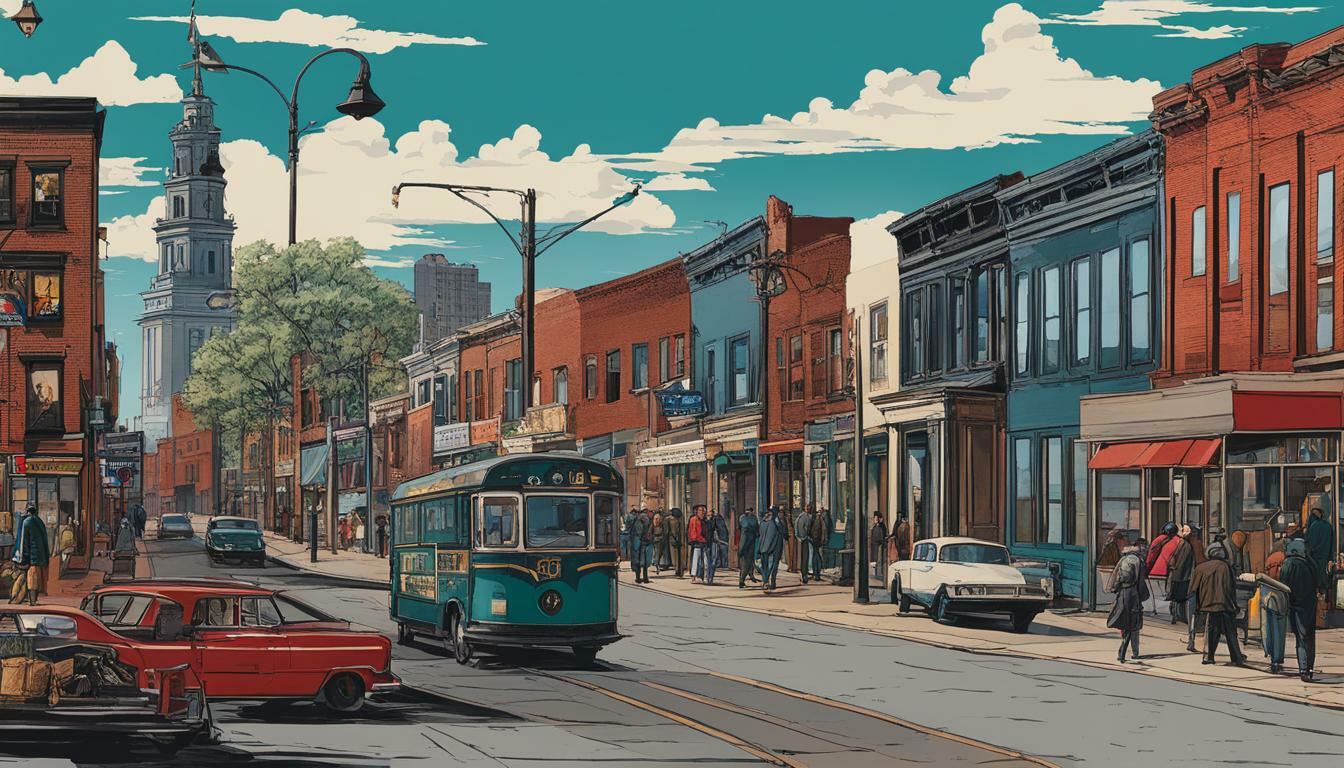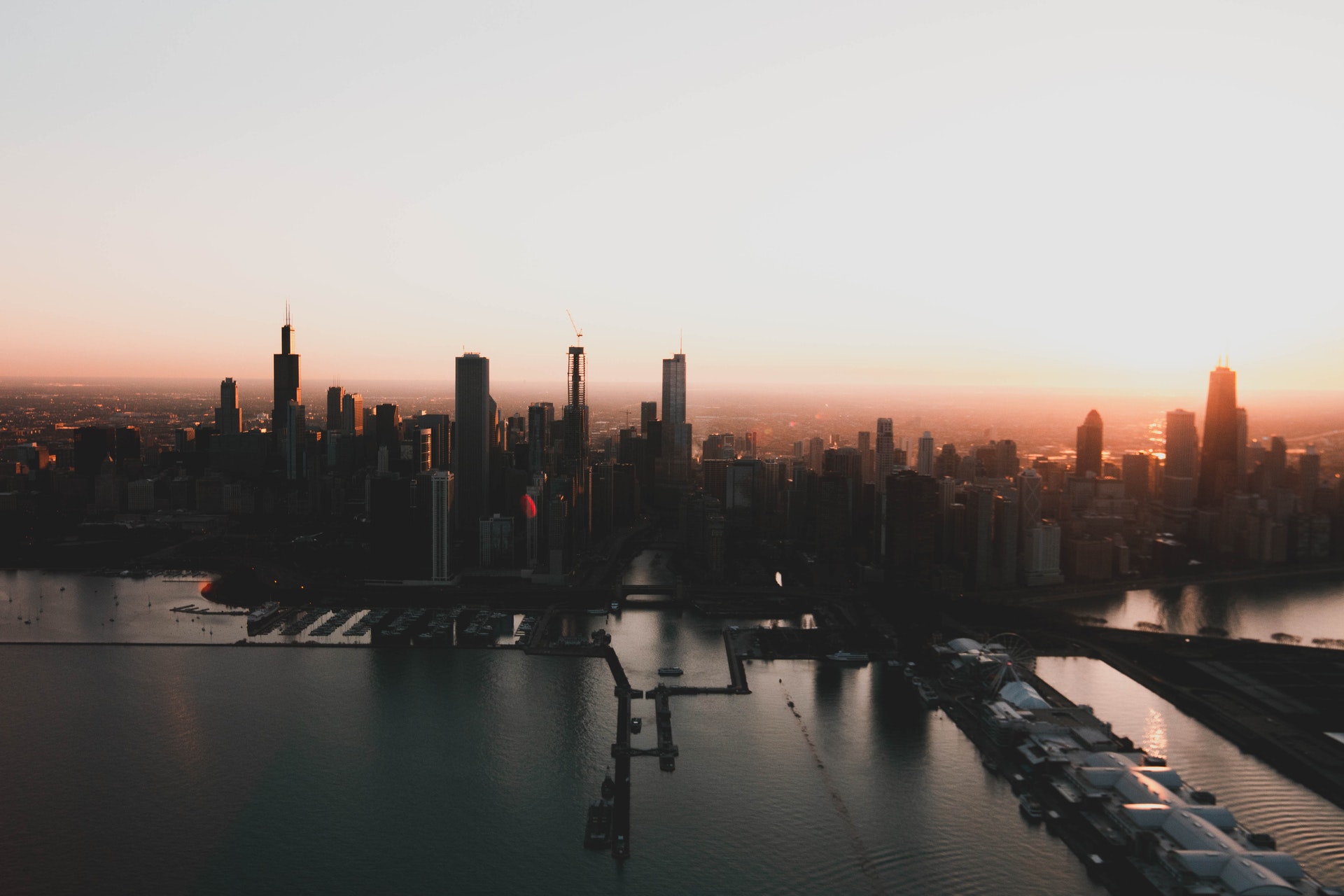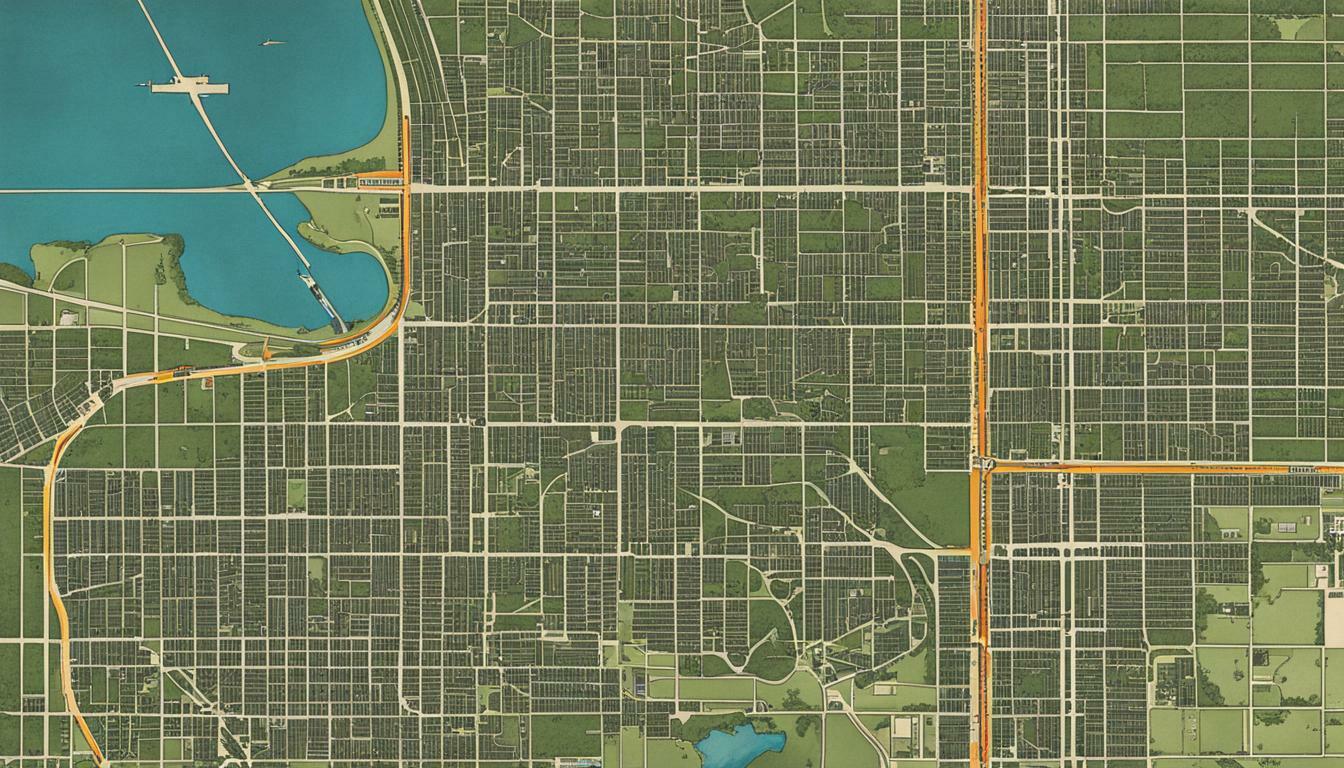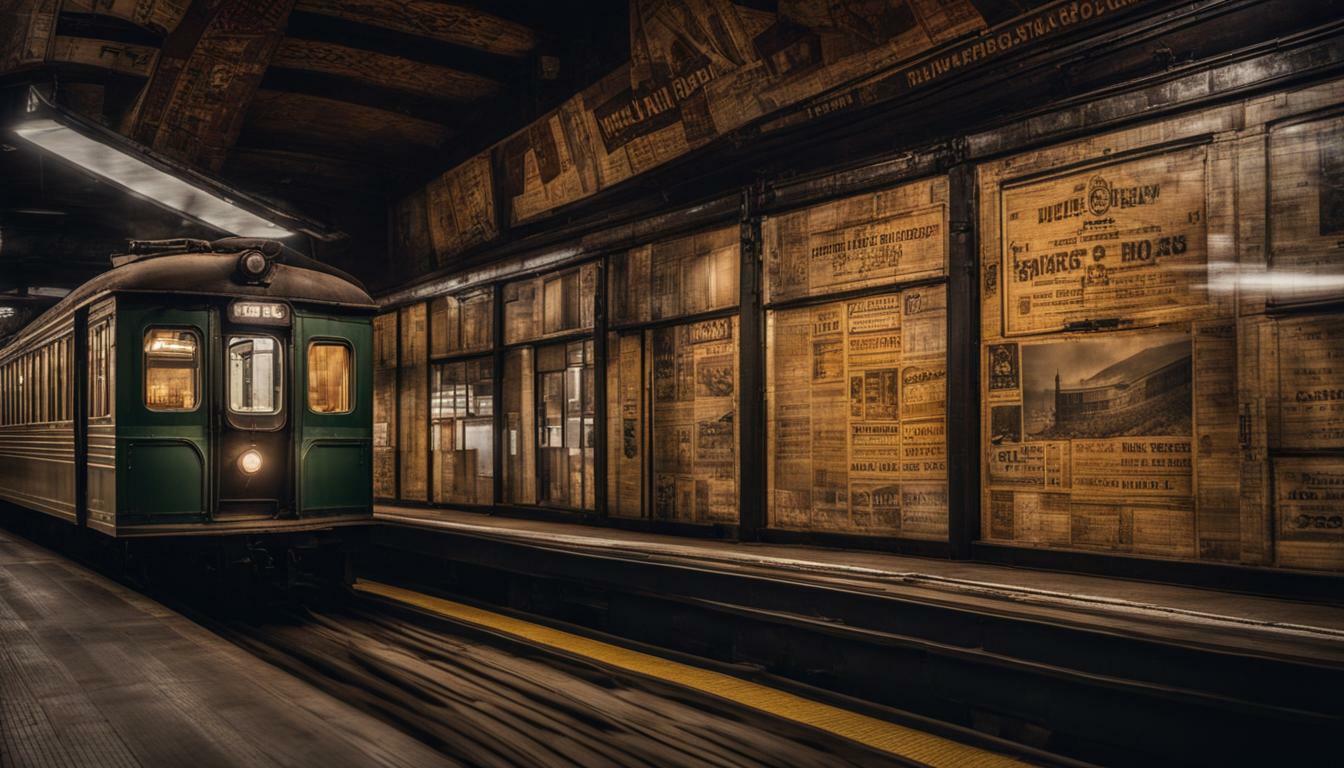Prohibition in Chicago during the early 20th century was not only a time of social upheaval but also a period that defined the city’s reputation for bootlegging, organized crime, and secret speakeasies. The history of Prohibition in Chicago dates back to the late 19th century when the Prohibition Party was formed to advocate for the banning of alcohol. The movement gained traction through the efforts of civic groups like the Anti-Saloon League, but it also faced opposition from individuals like Percy Andreae who believed religious interests were driving the campaign.
- The Prohibition era in Chicago was marked by illegal alcohol sales, bootlegging, and organized crime.
- The Prohibition Party and the Anti-Saloon League played significant roles in advocating for the banning of alcohol.
- Chicago became a hub for bootlegging and speakeasies during Prohibition.
- Notorious gangsters like Al Capone gained power and control over the illegal alcohol trade in the city.
- The enforcement of Prohibition was often met with violence and public backlash.
As we delve into the fascinating history of Prohibition in Chicago, we will uncover the rise of the temperance movement, the implementation of Prohibition as national law, the flourishing bootlegging industry, the influence of notorious gangsters, the secret world of speakeasies, the violence and enforcement surrounding Prohibition, the lasting legacy of this era, and the eventual end of the ban on alcohol. Join us on this journey through time as we explore the intriguing and often tumultuous history of Prohibition in the Windy City.
The Rise of the Temperance Movement
The history of Prohibition in Chicago can be traced back to the late 19th century when the Prohibition Party gained traction, advocating for the banning of alcohol, while the Anti-Saloon League emerged as a prominent voice against the sale and consumption of alcohol. These organizations played a crucial role in shaping the temperance movement in Chicago and Illinois as a whole.
The Prohibition Party, founded in 1869, sought to eliminate the “evils” associated with alcohol by promoting abstinence and the prohibition of its production and sale. They believed that banning alcohol would lead to a more moral and prosperous society. The party gained significant support in Chicago and played a pivotal role in pushing for legislation that would eventually lead to Prohibition.
| Year | Event |
|---|---|
| 1893 | The Anti-Saloon League is formed in Chicago, becoming one of the most influential temperance organizations in the country. |
| 1901 | Illinois becomes the first state in the nation to adopt statewide prohibition. |
| 1909 | Percy Andreae, a prominent Chicago businessman, publishes “The Other Side,” a book arguing against prohibition and exposing its religious motivations. |
| 1919 | The 18th Amendment to the U.S. Constitution, which established national prohibition, is ratified. |
Opposing the Prohibition Party and the Anti-Saloon League was Percy Andreae, a Chicago businessman who believed that Prohibition was driven more by religious interests than genuine concern for society. In his book “The Other Side,” Andreae argued against the banning of alcohol, highlighting the economic and social consequences it would have.
The rise of the temperance movement in Chicago set the stage for the eventual implementation of Prohibition. These early efforts laid the groundwork for a transformative period in the city’s history, one that would see the rise of bootlegging, gangsters, and speakeasies.
Prohibition Becomes Law
In 1920, the United States implemented national Prohibition, ushering in an era of illegal alcohol sales and transforming Chicago into a hub for criminal activities related to bootlegging. With the ban on alcohol, the demand for spirits skyrocketed, leading to the rise of clandestine operations and underground networks. Chicago, already known for its bustling nightlife, became a hotbed for illegal alcohol production and distribution.
The prohibition of alcohol sales didn’t deter Chicagoans from seeking out their favorite libations. Speakeasies, secret establishments that operated behind closed doors, thrived in the city’s hidden corners. These speakeasies became the social epicenters of the era, where people could gather to enjoy music, dance, and indulge in illicit drinking. From high-profile speakeasies frequented by the city’s elite to hidden basement clubs, Chicagoans found creative ways to flout the law.
The consequences of Prohibition extended far beyond secret nightclubs and hidden speakeasies. Organized crime gained a stronghold in Chicago, with notorious gangsters like Al Capone and his associates controlling the illicit alcohol trade. The city’s streets became battlegrounds, as rival gangs fought for control over territories and profits. The enforcement of Prohibition was met with resistance, leading to acts of violence and corruption within law enforcement ranks.
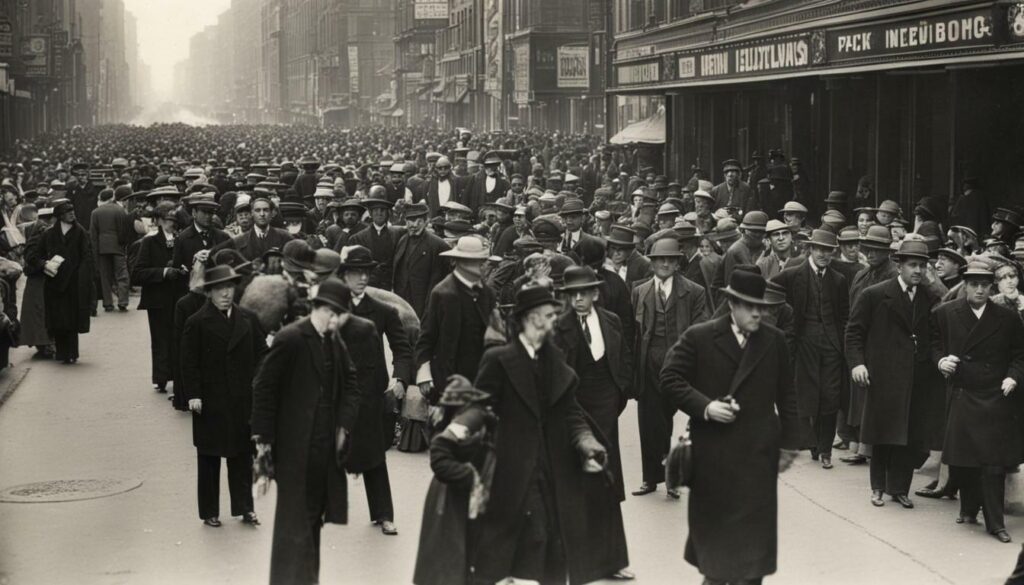
In 1933, the end of Prohibition marked the beginning of a new era for Chicago. While the ban on alcohol consumption was lifted, its legacy continues to shape the city’s history. The architectural landmarks and cultural institutions that emerged during the Prohibition era still stand as testaments to the resilience and ingenuity of Chicagoans. Today, the memory of Prohibition lives on in themed bars, events, and the collective fascination with Chicago’s bootlegging past.
Chicago as a Bootlegging Haven
The Roaring Twenties in Chicago witnessed an unprecedented surge in bootlegging activities, with the city becoming a hotspot for criminal enterprises and illegal alcohol production. As the national implementation of Prohibition in 1920 led to the ban on the sale and consumption of alcoholic beverages, Chicago quickly established itself as a haven for those seeking to profit from the underground liquor trade.
Bootlegging, the illegal production and distribution of alcohol, became a highly profitable venture in Chicago during this time. Notorious gangsters like Al Capone rose to power, establishing vast bootlegging networks that spanned the city. Speakeasies, secret bars where people could openly drink, flourished throughout Chicago, providing a space for socializing and revelry amidst the nationwide ban.
The city’s unique geographical location, situated on the shores of Lake Michigan and in close proximity to Canada, made it an ideal hub for smuggling operations. Criminal organizations took advantage of Chicago’s transportation infrastructure, using a network of tunnels, secret compartments in cars, and even the city’s extensive sewer system to transport illegal alcohol without detection.
| Key Players | Bootlegging Operations |
|---|---|
| Al Capone | Controlled the largest bootlegging operation in Chicago, with breweries and distilleries operating under his control. |
| George “Bugs” Moran | Headed the North Side Gang and competed with Capone for control of bootlegging territories, leading to violent conflicts like the infamous St. Valentine’s Day Massacre. |
| Dean O’Banion | Ran a successful bootlegging operation on the North Side before being killed in a gangland assassination, further escalating tensions between rival gangs. |
The illicit activities of the bootlegging industry fueled a surge in organized crime and violence. Gangland shootings and turf wars became a common occurrence in Chicago, as rival factions fought for control of lucrative territories. Law enforcement agencies struggled to combat the growing influence of these criminal enterprises, often falling prey to corruption and bribery.
Despite the inherent risks and dangers, bootlegging and the illicit alcohol trade brought immense wealth and prosperity to Chicago during the Prohibition era. However, with the eventual end of Prohibition in 1933, the era of illegal alcohol consumption in Chicago came to a close. The city’s criminal underworld would undergo significant transformations in the years to come, leaving behind a legacy of both intrigue and infamy.
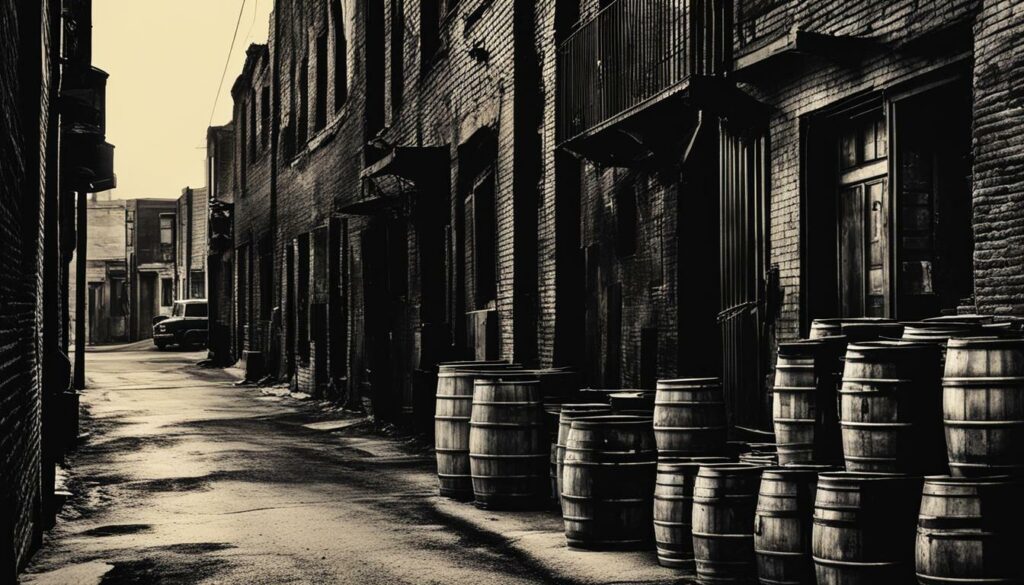
The Prohibition era in Chicago was dominated by notorious gangsters like Al Capone, whose criminal empire controlled the city’s illicit alcohol trade and wielded significant power. Capone, often referred to as “Scarface,” rose to prominence during this time, becoming one of the most infamous gangsters in American history. His operation was vast, spanning bootlegging, gambling, and other illegal activities, solidifying his control over the city.
Under Capone’s rule, Chicago became synonymous with organized crime and violence. His ruthless tactics, which included bombings, murders, and bribing public officials, ensured his supremacy in the criminal underworld. Capone cleverly used speakeasies, secret bars where illegal alcohol was sold and consumed, to maintain his influence and generate massive profits.
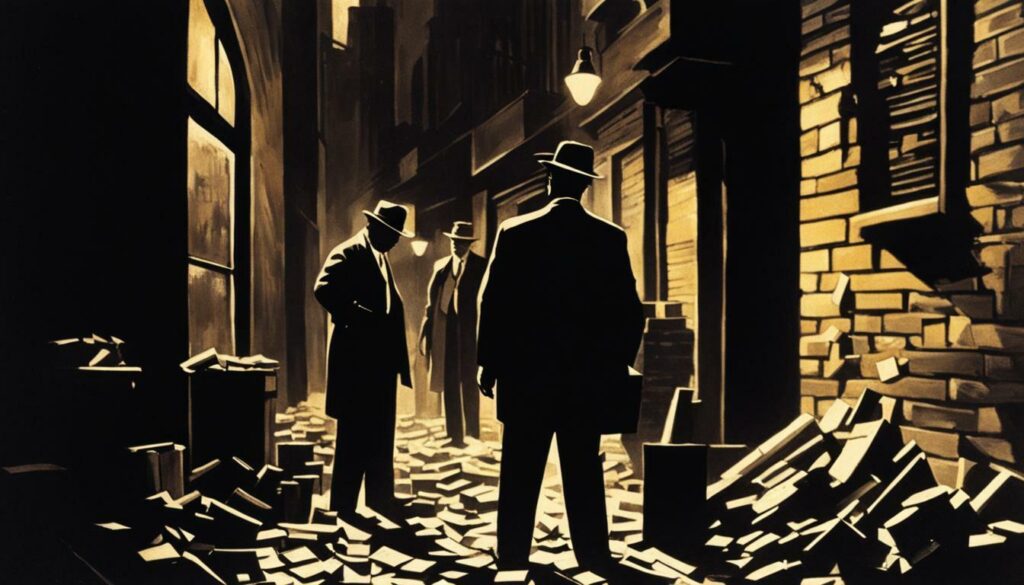
The Prohibition era in Chicago saw the rapid rise of other prominent gangsters as well. Notable figures like George “Bugs” Moran, Dion O’Banion, and Johnny Torrio all played significant roles in the city’s illicit activities. The bustling nightlife of Chicago was fueled by these criminal enterprises, with speakeasies operating in hidden corners and secret locations throughout the city.
The Legacy of Gangster Culture in Chicago
The influence of gangster culture during Prohibition left an indelible mark on Chicago. The architecture of the era, characterized by secret passageways, hidden rooms, and hidden entrances, still stands as a testament to this turbulent time. Some of Chicago’s most renowned historical landmarks, such as the Green Mill Cocktail Lounge and the Biograph Theater, have become iconic symbols of the city’s gangster past.
| Key Gangsters | Activities |
|---|---|
| Al Capone | Bootlegging, gambling, prostitution |
| George “Bugs” Moran | Rival gangster, involved in bootlegging and assassinations |
| Dion O’Banion | Irish-American gangster, leader of the North Side Gang |
| Johnny Torrio | Chicago Outfit boss, mentor to Al Capone |
The reign of gangsters like Al Capone during the Prohibition era forever changed the landscape of Chicago’s criminal history. While the era eventually came to a close with the end of Prohibition in 1933, its impact on the city remains palpable. Today, Chicago embraces its past, with themed bars and events that pay homage to the bootlegging era, allowing visitors to immerse themselves in the fascinating history of this notorious time.
Secret Speakeasies and Hidden Nightlife
The covert operation of speakeasies became synonymous with the Prohibition era in Chicago, providing an escape for individuals seeking to indulge in illegal alcohol consumption. These hidden establishments, often tucked away in basements or disguised as ordinary businesses, offered a unique and thrilling experience for those daring enough to enter.
Inside the speakeasies, patrons would find themselves immersed in a world of jazz music, dancing, and lively conversations, all accompanied by the clinking of glasses and the smooth flow of forbidden liquor. The allure of these secret venues extended beyond the thrill of breaking the law; they became symbols of rebellion and defiance against the restrictive temperance movement.
Tables were often packed with people from all walks of life, mingling together in an atmosphere of camaraderie. The secrecy of the speakeasies fostered a sense of community and unity among the patrons, as they all shared in the knowledge that they were partaking in something forbidden.
The Rise of the Jazz Age
The Prohibition era also coincided with the rise of the Jazz Age, and speakeasies played a pivotal role in the flourishing jazz scene in Chicago. Famous musicians such as Louis Armstrong and Duke Ellington performed in these venues, captivating audiences with their innovative sounds and lively performances.
The cultural significance of these hidden nightspots cannot be overstated. They not only provided an escape from the monotony and restrictions of everyday life but also became breeding grounds for creativity and artistic expression. The speakeasies of Chicago were the birthplace of a new era of music and culture, forever leaving their mark on the city’s history.
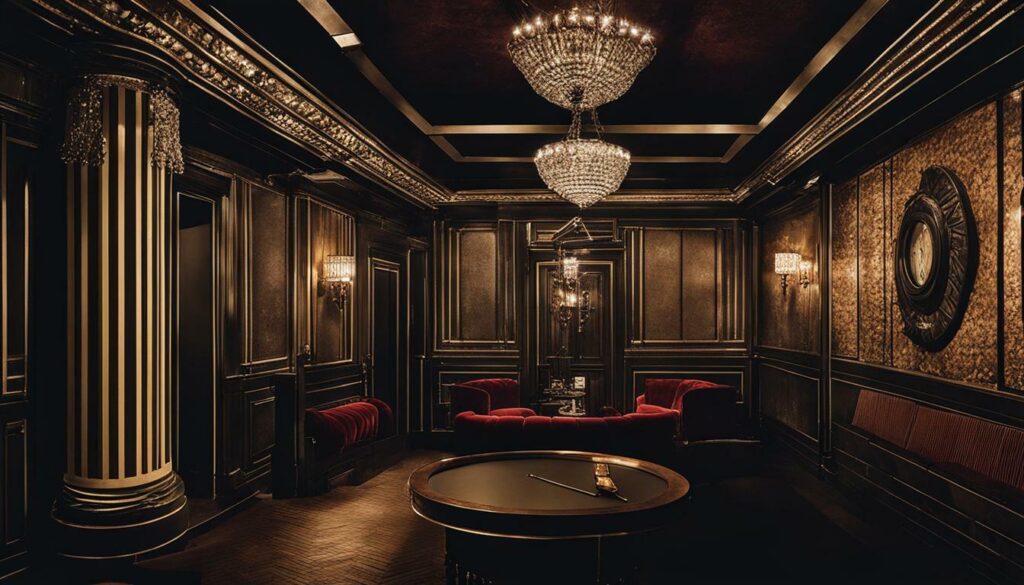
| Key Aspects of Speakeasies in Chicago |
|---|
| Hidden in basements or disguised as ordinary businesses |
| Escape from the restrictions of Prohibition |
| Thriving jazz scene with famous musicians |
| Symbols of rebellion and defiance |
| Community and camaraderie among patrons |
The speakeasies of Chicago may be long gone, but their legacy lives on. Today, themed bars and restaurants pay homage to this bygone era, offering patrons a taste of the clandestine world that once thrived during Prohibition. Through these modern-day recreations, we can catch a glimpse of the excitement and allure that surrounded the secret speakeasies of Chicago.
Violence and Enforcement
The enforcement of Prohibition in Chicago was marked by violent clashes between law enforcement and criminal organizations, as well as an increase in overall crime rates. With the ban on alcohol, the city quickly became a battleground for bootleggers and law enforcement, leading to frequent shootouts and violent confrontations.
Criminal organizations, such as those led by notorious gangsters like Al Capone, took advantage of the lucrative illegal alcohol trade. They controlled underground networks of speakeasies, where people could secretly consume alcohol during Prohibition. These criminal enterprises were well-armed and willing to use violence to protect their operations.
Law enforcement agencies, on the other hand, faced significant challenges in their efforts to enforce Prohibition. They often lacked the resources and manpower to effectively combat the widespread illegal alcohol trade. Corruption within the police force further complicated matters, as some officers were bribed by the criminal organizations.
The clashes between law enforcement and criminal organizations resulted in a wave of violence throughout Chicago. Shootouts between rival gangs and the police became common occurrences, leading to the loss of innocent lives. This violence, combined with the increase in crime rates, fueled public outrage and a growing sentiment that Prohibition was doing more harm than good.
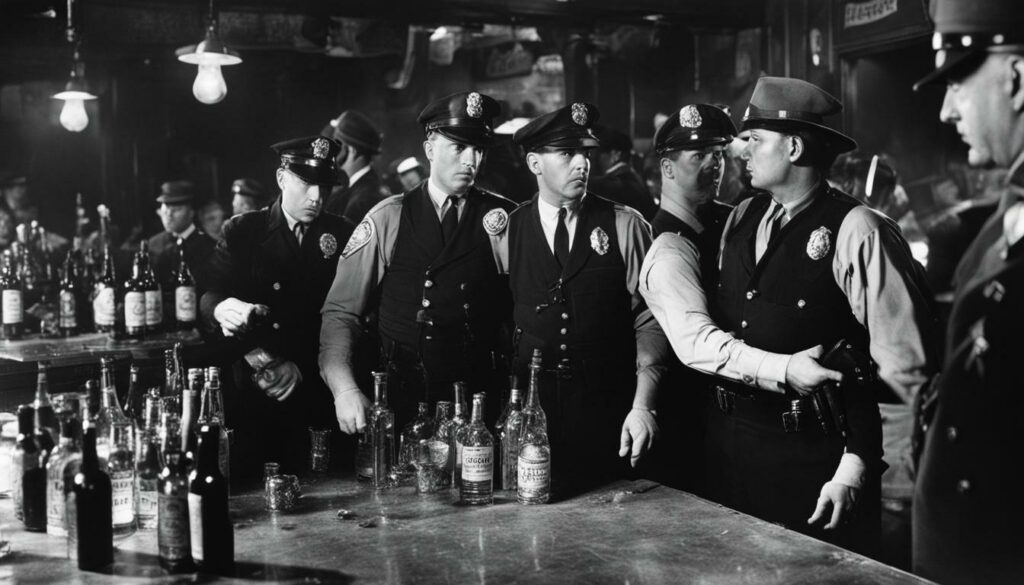
| Year | Number of Prohibition-related Homicides in Chicago |
|---|---|
| 1920 | 72 |
| 1921 | 109 |
| 1922 | 134 |
| 1923 | 169 |
As the violence escalated and public sentiment turned against Prohibition, law enforcement agencies were forced to reassess their approach. The focus shifted towards targeting the criminal organizations rather than individual consumers, leading to high-profile arrests and the eventual downfall of gangsters like Al Capone.
References:
- Johnson, E. (2009). The Warring City: Violence in Prohibition-era Chicago, 1920-1933. Journal of Social History, 43(3), 573-596.
- Okrent, D. (2010). Last Call: The Rise and Fall of Prohibition. Scribner.
The Legacy of Prohibition
The legacy of Prohibition can still be seen in the historical landmarks of Chicago, which serve as a reminder of the city’s tumultuous past during the ban on alcohol. Despite the passage of time, these landmarks stand as a testament to the era that shaped Chicago’s identity and left an indelible mark on its history.
One such landmark is the historic Green Mill Cocktail Lounge, located in the Uptown neighborhood. Originally a speakeasy during Prohibition, the Green Mill was a popular gathering place for Chicago’s elite and notorious gangsters alike. Today, visitors can step back in time and experience the ambiance of the speakeasy era, with its vintage decor and live jazz performances.
Another prominent landmark is the Chicago Historical Society, now known as the Chicago History Museum. This institution houses an extensive collection of artifacts and exhibits that chronicle the city’s history, including the Prohibition era. Visitors can explore the stories of bootleggers and gangsters, learn about the rise and fall of Prohibition, and gain a deeper understanding of the social and cultural impact it had on Chicago.
| Name | Location | Description |
|---|---|---|
| Green Mill Cocktail Lounge | 4802 N Broadway St, Chicago, IL 60640 | A historic speakeasy turned jazz club that offers a glimpse into Chicago’s Prohibition past. |
| Chicago History Museum | 1601 N Clark St, Chicago, IL 60614 | A renowned museum that explores the city’s history, including its Prohibition era, through exhibits and artifacts. |
Lastly, the Old Town Ale House is a hidden gem that encapsulates the spirit of defiance and resilience from the Prohibition era. Located in the historic Old Town neighborhood, this beloved neighborhood bar has been a gathering place for artists, writers, and locals for decades. Its walls are adorned with eclectic artwork, including satirical depictions of Chicago’s notorious gangsters, offering a whimsical nod to the city’s past.
The legacy of Prohibition in Chicago lives on through these historical landmarks, preserving the stories and memories of a time when the city was caught in the grip of an alcohol ban. Visiting these sites provides a window into a fascinating chapter in Chicago’s history, where secret speakeasies thrived, notorious gangsters ruled, and the city’s resilience prevailed.

The year 1933 marked the end of Prohibition in the United States, bringing an end to the era of illegal alcohol consumption in Chicago and paving the way for significant societal changes. For over a decade, Chicago had experienced the rise of rampant bootlegging and the domination of notorious gangsters like Al Capone. But with the repeal of the 18th Amendment, Chicago and the nation as a whole were poised for a shift in dynamics.
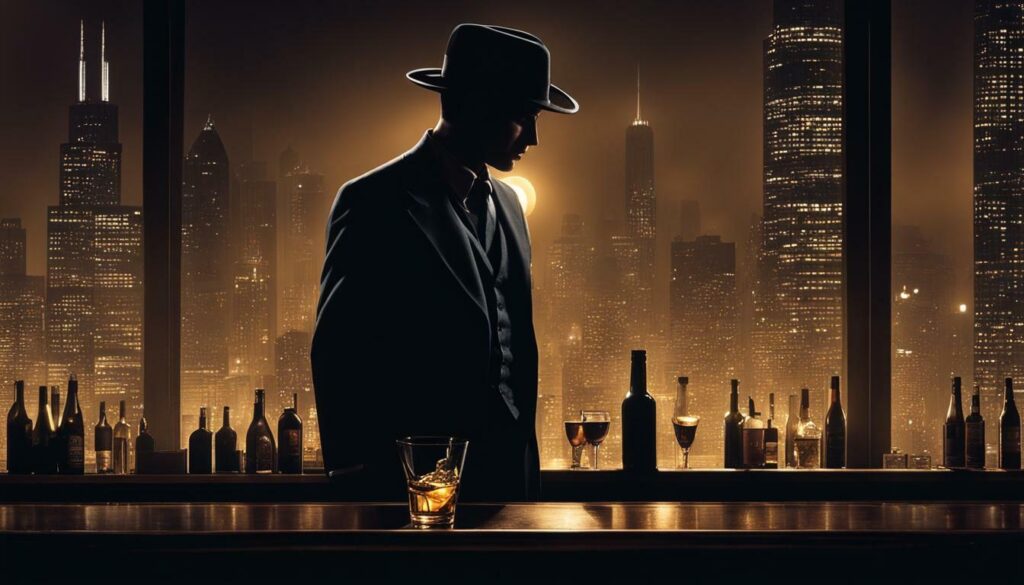
The repeal of Prohibition meant that legal bars were once again allowed to operate openly, changing the social and cultural landscape of Chicago. The reopening of establishments that had once been deemed illegal created a newfound sense of freedom for Chicagoans. The city’s nightlife experienced a revival, as people could now openly enjoy a drink and socialize without the fear of breaking the law.
With the end of Prohibition came a reevaluation of society’s approach to alcohol consumption. Lessons learned from the failed attempt to ban alcohol entirely led to a more regulated system of control. The impact of Prohibition on society, both positive and negative, became a topic of reflection and discussion. It shaped the ongoing debates on alcohol regulation and influenced the cultural attitudes towards drinking.
Today, there is a renewed interest in the Prohibition era, including the history of bootlegging and the secret world of speakeasies. Themed bars and events that pay homage to this period have gained popularity, allowing people to experience a glimpse of Chicago’s past. By looking back at the end of Prohibition, we can better understand the lasting effects it had on the city and its role in shaping the present.
Evolving Socio-Cultural Landscape
With the repeal of Prohibition, Chicago experienced a transformation in its socio-cultural landscape as legal bars and establishments emerged, reshaping the city’s nightlife scene. The end of Prohibition in 1933 marked a significant shift in Chicago’s social fabric, as the once-thriving underground speakeasies made way for legitimate establishments serving alcoholic beverages. The city became a hub for a new wave of nightlife, with bars, clubs, and restaurants opening their doors to the public, offering a variety of entertainment options.
This newfound freedom to openly consume alcohol brought about a vibrant and diverse cultural scene in Chicago. People flocked to the newly established bars and clubs, indulging in the pleasures of live music, dancing, and socializing. The city’s jazz and blues music scenes flourished, attracting talented musicians from across the country and solidifying Chicago’s reputation as a cultural capital. The emergence of iconic venues such as the Green Mill Cocktail Lounge and the historic Pump Room added to the allure of Chicago’s nightlife and cemented its status as a destination for entertainment.
As legal bars and establishments thrived, they became a focal point for social gatherings and celebrations. Chicago’s evolving socio-cultural landscape was reflected in the diverse range of venues available, catering to different tastes and preferences. From upscale cocktail lounges to neighborhood taverns, Chicago offered something for everyone. The city’s rich history and architectural landmarks also played a role in shaping the character of its nightlife. Venues like the historic Berghoff Restaurant, with its German-American heritage, and the iconic Chicago Theatre added a touch of nostalgia and grandeur to the drinking and dining scene.

The evolution of Chicago’s socio-cultural landscape following Prohibition not only revitalized the city’s nightlife but also contributed to its overall identity and reputation. Today, Chicago continues to be known for its vibrant bar and restaurant scene, constantly evolving and adapting to changing trends. The legacy of Prohibition serves as a reminder of the city’s resilience and ability to bounce back from challenging times, creating a cultural tapestry that showcases the diversity and spirit of Chicago.
Lessons Learned
The era of Prohibition in Chicago left a lasting impact, serving as a lesson in the challenges of regulating alcohol and shaping public perception surrounding its consumption. The attempt to ban alcohol only fueled a thriving underground economy and led to an increase in organized crime. This period revealed the limitations of legislation in controlling human behavior and the unintended consequences that can arise from prohibitionist policies.
One of the key lessons learned from Prohibition is the importance of aligning public sentiment with regulatory measures. Despite the passage of the 18th Amendment and the Volstead Act, a significant portion of the population continued to drink alcohol, even if it meant turning to illegal channels. This highlighted the need for legislation that reflects the values and preferences of the society it seeks to govern.
Prohibition also shed light on the inherent difficulties of enforcing strict bans on popular substances. The increase in illegal alcohol sales demonstrated the resilience of the black market and the capacity of criminal organizations to adapt and thrive under restrictive laws. This stark reality raises questions about the effectiveness of prohibitive measures in achieving their intended goals.
The Impact of Prohibition
Chicago’s experience with Prohibition offered valuable insights into the consequences of limiting access to alcohol. The rise of speakeasies and the escalation of violence associated with the illegal alcohol trade revealed the unintended social and economic ramifications of banning a widely consumed product. The era of Prohibition in Chicago serves as a cautionary tale, reminding us of the complexities involved in regulating behavior and the need for thoughtful and evidence-based approaches.

| Lesson | Explanation |
|---|---|
| 1. Public sentiment matters | Prohibition’s failure to align with societal attitudes towards alcohol consumption showcased the importance of considering public sentiment when enacting legislation. |
| 2. Black market resilience | The thriving illegal alcohol trade during Prohibition highlighted the resilience of the black market and its ability to adapt and profit under prohibitive laws. |
| 3. Unintended consequences | The rise of organised crime and the increase in violence demonstrated the unintended social and economic consequences of banning alcohol. |
| 4. The limitations of regulation | Prohibition exposed the challenges of enforcing strict bans on popular substances and the limitations of legislation in controlling human behavior. |
Reviving the Past
The intrigue and fascination with Chicago’s Prohibition era continue to captivate residents and visitors alike, as themed bars and events revive the spirit of the city’s notorious past. Step back in time and experience the thrill of the roaring twenties, where speakeasies overflowed with flappers and gangsters, and the forbidden allure of illegal alcohol permeated the air.
These modern-day establishments pay homage to Chicago’s historical landmarks, recreating the ambiance of secret speakeasies that once dotted the city’s landscape. From hidden entrances to password-protected access, these atmospheric bars transport patrons to a bygone era of jazz, rebellion, and excess.
Immerse yourself in the era of Al Capone and his gangster ilk as you sip on carefully crafted cocktails that harken back to the recipes of old. The bartenders, clad in suspenders and fedoras, skillfully mix drinks using ingredients and techniques reminiscent of the Prohibition era. It’s an experience that not only satisfies the palate but also offers a glimpse into Chicago’s rich history and the enduring legacy of the Prohibition era.
As you raise your glass to the past, take a moment to appreciate the architectural wonders that served as the backdrop to Chicago’s bootlegging and speakeasy culture. The iconic buildings that still stand today, such as the Chicago Board of Trade and the historic Palmer House, serve as reminders of the city’s resilience and ability to adapt to changing times.

In the midst of the modern hustle and bustle, themed bars and events offer an escape into the past, allowing visitors to relive the excitement and intrigue of Chicago during the Prohibition era. Raise a glass, dance to the jazz-infused tunes, and celebrate the city’s fascinating history.
| Key Points | Keywords |
|---|---|
| Themed bars and events revive the spirit of Chicago’s Prohibition era | chicago historical landmarks |
| Modern-day establishments recreate the ambiance of speakeasies | chicago bootlegging, chicago speakeasies |
| Carefully crafted cocktails and skilled bartenders transport patrons to the past | chicago historical landmarks |
| Chicago’s architectural wonders serve as reminders of the city’s resilience | chicago historical landmarks |
Conclusion
The history of Prohibition in Chicago is a captivating tale of bootlegging, notorious gangsters, and hidden speakeasies that left an indelible mark on the city’s cultural and historical landscape.
From the rise of the temperance movement and the implementation of national Prohibition in 1920, to the thriving underground economy of bootlegging and the rise of infamous gangsters like Al Capone, Chicago became synonymous with the illicit trade in illegal alcohol.
The enforcement of Prohibition was met with challenges and often resulted in violent clashes between law enforcement and criminals. However, the era also gave birth to a unique subculture of secret speakeasies, where people could indulge in the forbidden pleasure of alcohol.
With the end of Prohibition in 1933, Chicago experienced a significant shift in its socio-cultural landscape. Legal bars reopened, and the city’s nightlife took on a new form. The legacy of Prohibition can still be seen today in Chicago’s historical landmarks, many of which became iconic symbols of the era.
FAQ
What is the history of Prohibition in Chicago?
The history of Prohibition in Chicago dates back to the late 19th century when organizations like the Prohibition Party and the Anti-Saloon League advocated for the banning of alcohol. Prohibition became national law in 1920, leading to a rise in illegal alcohol sales, bootlegging, and organized crime in the city.
How did Prohibition impact Chicago?
Prohibition had a significant impact on Chicago, turning the city into a hub for illegal alcohol sales and a hotbed for organized crime. Notorious gangsters like Al Capone gained control over the bootlegging operations, and speakeasies flourished. The enforcement of Prohibition led to incidents of violence and public backlash.
How many speakeasies were operating in Chicago during Prohibition?
It is estimated that during Prohibition, there were around 10,000 speakeasies operating in Chicago. These secret establishments provided a place for people to consume alcohol illegally.
Did Prohibition end in Chicago?
Yes, Prohibition came to an end in Chicago in 1933. With the repeal of the 18th Amendment, the bootlegging industry came to an end, and legal bars reopened. The era of illegal alcohol consumption in Chicago came to a close.
What was the legacy of Prohibition in Chicago?
The legacy of Prohibition in Chicago includes its influence on architectural landmarks and cultural institutions that still stand today. The socio-cultural landscape of the city was also reshaped, with changes in the nightlife and attitudes towards alcohol consumption.
What lessons were learned from Prohibition?
Prohibition taught society important lessons about the regulation of alcohol and its impact on society. It highlighted the challenges of enforcing a ban and sparked a cultural shift in attitudes towards alcohol. These lessons continue to shape alcohol regulation today.
Is there still interest in the Prohibition era in Chicago?
Yes, there is still significant interest in revisiting the Prohibition era in Chicago. Themed bars and events that pay homage to the city’s bootlegging history have gained popularity, allowing people to experience a taste of the past.
Source Links
- http://websites.umich.edu/~eng217/student_projects/nkazmers/prohibition1.html
- https://news.wttw.com/2013/01/03/uncovering-roots-organized-crime-chicago
- https://www.chicagotribune.com/visuals/chi-prohibition-chicago-20140725-photos-photogallery.html


